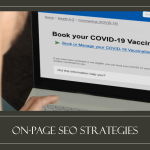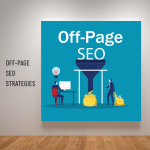SEO-friendly blog content plays a key role in improving visibility and increasing organic traffic. Search Engine Optimization (SEO) is a process of optimizing your site and content to rank higher in search results like Google. By following SEO best practices, your blog is more likely to appear higher in rankings when people search for related keywords or topics.
SEO-friendly blog content is essential for visibility, reaching your target audience, and driving organic traffic. Implementing SEO best practices and optimizing for keywords and user intent helps your blog succeed in the competitive online world.
Table of Contents:
- The Importance of Optimized Content for Online Visibility
- Conducting Keyword Research
- Structuring Your Content for SEO
- Optimizing On-Page Elements
- Creating Engaging and Valuable Content
- Enhancing User Experience and Mobile Optimization
- Monitoring Performance and Making Improvements
1. The Importance of Optimized Content for Online Visibility
In today's digital landscape, the content you publish on your website plays an integral role in your online success. Specifically, content that is enhanced for search engine optimization (SEO) can yield significant benefits. Studies show that over half of all website traffic comes from search engines, so crafting content that ranks highly in search results is key to driving more visitors to your site.
SEO-optimized content also generates exponentially more traffic than social media. While social platforms are useful for building brand awareness, SEO can produce over 1,000% more website traffic. For this reason, an SEO strategy should be a central part of your content marketing plan.
When you optimize your content for search engines, you make it much easier for people to find your content, products, and services through organic search. This expands the reach of your website and helps you connect with your target audience.
The Importance of Optimized Content for Your Website:
Content that is optimized for SEO plays an essential role in maximizing your website's visibility and performance. When you enhance your content for search engines, you improve your chances of ranking higher in search results. Higher rankings equal more traffic, as well as credibility. Appearing at the top of search results establishes your website as a trusted source, leading readers to engage more with your content.
Choosing and Utilizing the Right Keywords:
Selecting and incorporating the right keywords is key to creating optimized content. To determine the best keywords, consider what searchers are looking for when they search for topics related to your website. Analyze the keywords your target audience would likely use.Performing keyword research using tools such as Ahrefs or Google Keyword Planner can uncover keywords that balance search volume and competition. Once you've identified valuable keywords, strategically include them in your content, such as in headings, subheadings, and throughout the body text. However, be sure to use keywords in a natural, conversational tone.
Understanding User Intent for Effective Content:
User intent refers to the motivation behind a search query. Creating content that satisfies user intent leads to higher rankings and more relevant content. To fulfill user intent, thoroughly research your target keywords and evaluate the top-ranking search results. Identify common themes, formats, and information provided in these results. Crafting content that meets user intent enhances the user experience and boosts your organic traffic.
SEO-optimized content is essential for increasing your website's visibility, credibility, and traffic. By enhancing your content for search engines, choosing high-value keywords, and aligning with user intent, you can significantly improve your website's performance and reach your target audience.
2. Conducting Keyword Research
Conducting thorough keyword research and optimizing your content accordingly are key components of search engine optimization. By identifying relevant keywords that match your audience's intent, you can improve your website's visibility and ranking in search results. Here is a comprehensive approach to researching and optimizing keywords:
Keyword Research Process:
First, understand your target audience and their search intent. Consider their needs, interests, and search behaviors. Use keyword research tools such as Google Keyword Planner, SEMrush, MozBar, or Keyword Surfer to uncover keywords. These tools provide data on search volume, competition, and related keywords. Analyze your keyword data to prioritize the most important keywords and topics to cover in your content.
Finding Relevant Keywords:
Brainstorm keywords your audience might use based on the topics you want to cover. Consider long-tail keywords, which are more specific and face less competition. They often indicate strong intent and drive targeted traffic.Choose keywords balancing search volume and competition. High volume shows popularity, while lower competition improves your chance of ranking well. Leverage social media, forums, and surveys to understand your audience's search language. Use these insights for keyword ideas.Use tools like Ahrefs, KeywordTool.io or Long Tail Pro to expand keyword lists and gather data on volume, difficulty, and related terms. Explore latent semantic indexing or LSI. Identify topically relevant keywords to supplement your primary keywords. LSI provides context for search engines and improves content relevance.
Optimizing Your Content:
Once you have keywords, incorporate them into your content strategically, focusing on user experience over keyword density. Place keywords in title tags, meta descriptions, and heading tags to signal relevance to search engines. Include keywords naturally in your content to provide value to readers. Avoid keyword stuffing, which harms rankings.Optimize on-page elements such as image alt tags, URL slugs, and internal links by adding keywords where suitable. Create high-quality, engaging content that addresses the search intent behind your keywords and answers user queries completely. Monitor performance with tools like Google Analytics to track keyword rankings, traffic, and engagement. Refine your optimization strategy based on the data.
3. Structuring Your Content for Maximum SEO Impact
Several key elements can enhance both the readability and SEO of your content. Here are some strategies to consider:
The Power of Headings and Subheadings:
Using headings (H1, H2, etc.) and subheadings improves readability and helps search engines understand your content's hierarchy. Naturally incorporate keywords in headings and subheadings to signal relevance to search engines. However, focus on creating informative headings that accurately represent the content. Headings and subheadings make content more scannable and help readers find information quickly, improving experience and engagement.
Incorporating Lists and Bullet Points:
Bullet points and lists break down complex information into digestible chunks, making content more scannable and reader-friendly. When creating lists, naturally include keywords and variations while providing concise, valuable information. Search engines often display lists or bullets in featured snippets, so optimizing content this way can increase your chances of appearing in them.
Using Tables and Graphics for Clarity:
Incorporating tables and graphics enhances clarity and helps visualize complex data or concepts. Search engines appreciate clear, well-structured information. Only use tables or graphics if they are relevant and valuable. Include descriptive alt text for images and provide context or summaries for tables so search engines understand their purpose.
By structuring content with headings, subheadings, lists, and graphics, you can improve readability, experience, and SEO. Focus on providing value to your audience while incorporating keywords and optimizing for search engines. Monitor performance using analytics to assess impact and refine as needed.
4. Optimizing On-Page Elements
Optimizing on-page elements is key to improving your web pages' visibility and ranking. Here are essential elements to focus on:
Crafting Compelling Meta Titles and Descriptions:
Meta titles and descriptions are HTML tags providing summaries of your pages in search results. Write unique meta titles capturing your content's essence while following SEO guidelines. Naturally incorporate keywords and use action-oriented language to resonate with readers. Write informative meta descriptions accurately describing your content and enticing clicks. Include keywords and ensure readability within the recommended length.
Creating SEO-Friendly URLs:
SEO-friendly URLs are concise, descriptive, and keyword-rich, helping search engines and users understand page content. Naturally incorporate relevant keywords in the URL structure, using hyphens between words and avoiding extra parameters or special characters. Use static URLs that are readable and memorable, contributing to better experience and easier content sharing.
The Importance of Internal and External Linking:
Internal linking connects your pages with hyperlinks, helping search engines understand site structure and page relationships. It also provides seamless navigation for users. Use descriptive anchor text with keywords when linking internally to provide context. External linking links to authoritative and relevant sources, enhancing content credibility, improving experience by offering resources, and potentially attracting backlinks. When linking externally, choose reputable sources providing information valuable and relevant to your audience.
By optimizing these elements, you can improve page visibility, relevance, and user experience. Craft compelling meta data and descriptions, create keyword-rich URLs, and implement internal and external linking strategies to boost your site's SEO impact. Regularly monitor performance and adjust based on analytics and best practices.
5. Creating Engaging and Valuable Content
Creating valuable and engaging content is key to capturing and keeping your audience's attention. Here are three important aspects to focus on:
Addressing Common Queries and Providing Direct Answers:
Understand your audience's common questions and pain points to create content that directly addresses their needs and provides solutions. Conduct keyword research to identify audience queries and craft content with comprehensive, accurate answers. Use headings, subheadings, and bullets to make information easy to find. Implement FAQs, “how-to” guides, and informative blog posts to address queries and establish authority.
Incorporating Rich Media and Visual Elements:
Rich media and visuals like images, videos, infographics, and interactive content enhance engagement and shareability. Use relevant, high-quality visuals complementing your written content to capture attention and convey information visually. Infographics present complex data and concepts concisely and visually. Videos provide engaging, informative content like tutorials, interviews, or demos. Optimize rich media for search engines using alt tags, descriptions, and captions.
Writing for Readability and User Engagement:
Easy to read and understand content engages users and aids comprehension. Use short paragraphs and sentences to improve readability. Maintain clear flow and coherence, connecting introduction, body, and conclusion. Incorporate storytelling, compelling narratives, and relatable examples to captivate and engage.Utilize formatting like headings, subheadings, bullets, and bolding to highlight information and improve scannability.
6. Enhancing User Experience and Mobile Optimization
Enhancing user experience (UX) and mobile optimization is key to creating a positive experience for your audience. Here are four important aspects:
The Significance of Mobile-Friendly Design:
Mobile optimization means designing your site for an optimal mobile experience. It impacts UX, engagement, rankings, conversion rates, and more. Use responsive design so your site adapts to screens, offering a consistent experience across mobile, tablet, and desktop. Simplify navigation and make important content easily accessible on small screens. Mobile-friendly design improves UX and SEO by making your site more discoverable and accessible to mobile users.
Optimizing Website Speed and Performance:
Website optimization improves performance, speed, and UX by optimizing elements like design, content, images, and code. A fast site is crucial for satisfaction, lower bounce rates, and higher search rankings. Optimize speed by compressing images, minifying CSS/JavaScript, using browser caching, and CDNs to deliver content efficiently. Monitor and optimize performance with speed tests, metrics analysis, and fixing issues impacting UX.
Creating Intuitive Navigation and Clear CTAs:
Intuitive navigation lets users easily find information, reducing frustration and improving UX. Organize navigation logically and descriptively with clear menu labels and hierarchy. Implement clear CTAs guiding users to actions like purchases, newsletter signups or contact. Use distinct buttons, icons or links for CTAs, making them stand out and identifiable. Incorporate visual cues guiding attention to key areas and actions. Implement user-friendly forms minimizing fields.Conduct user testing and gather feedback to identify pain points and make improvements enhancing navigation and optimizing CTAs.
By focusing on mobile design, optimizing speed/performance, and creating intuitive navigation with clear CTAs, you significantly enhance your site's UX, increasing engagement, conversions, and customer satisfaction.
7. Monitoring Performance and Making Improvements
Monitoring performance and making continuous improvements are key to any SEO and digital marketing strategy. By tracking rankings and traffic, analyzing behavior and engagement, and refining for growth, you optimize your site's performance and achieve long-term success. Here's how:
Tracking Keyword Rankings and Organic Traffic:
SEO metrics like visibility, rankings, and organic traffic show how well your SEO efforts work. Use SEO tools to monitor rankings, analyze competitors, and track search position changes. Regularly check your site's performance for target keywords and refine SEO strategies.
Analyzing User Behavior and Engagement Metrics:
Customer experience analytics provide metrics such as usage, stickiness, time to value, engagement, and retention to improve product performance and user onboarding. User Activity Monitoring (UAM) tools track and analyze end-user behavior on devices and networks, detecting threats and improving security. Tools like Google Analytics gather data on behavior like page views, bounce rates, session duration, and conversion rates. Analyze to understand preferences and identify improvements.Use heatmaps and click tracking to visualize interactions, identifying patterns, popular sections, and areas for improvement.
Strategies for Iterative Improvement and Growth:
Continuously analyze data from rankings, traffic, and behavior to find trends, opportunities, and areas for improvement. Identify high-performing keywords and optimize content/site structure to improve rankings and traffic. Use A/B testing and CRO techniques to optimize design, layout, and UX. Regularly review and update SEO strategies based on insights from tracking and analysis for continuous improvement and growth. Competitor analysis provides insights into their traffic, visibility, and top keywords so you can optimize to outperform them.
By monitoring rankings, analyzing behavior/engagement, and refining iteratively, you enhance your site's performance, increase organic traffic, and achieve sustained online growth.
Conclusion:
Writing SEO-friendly blog content is key to improving visibility, reaching your target audience, and increasing organic traffic. By following the strategies above, you can optimize your content to rank higher in search results and make it more likely your blog is found by your audience. By consistently implementing these strategies and techniques, you can allure more organic traffic to your blog and increase its visibility on search engine results pages, ultimately impelling the success of your blog.
Frequently Asked Questions (FAQs):
- What is SEO, and why is it important for my blog?
SEO stands for search engine optimization. It is important for your blog because it helps increase organic traffic from search engines like Google. By optimizing your content for SEO, you can rank higher in search results and gain more visibility and readers. - How can I conduct keyword research for my blog content?
You can conduct keyword research for your blog using tools like Google Keyword Planner, Ahrefs, and Moz. Analyze search volume and competition to find keywords that will drive traffic to your content. Look for long-tail keywords that are more specific. - What are the best practices for structuring content to make it SEO-friendly?
Best practices for SEO-friendly content include: optimized titles and meta descriptions, internal linking, faster page load times, mobile-friendliness, schema markup, and content quality. Focus on reader intent and provide value with your content. - How do I optimize on-page elements like meta titles and descriptions?
You can optimize meta titles by making them clear and concise, placing keywords at the front, and keeping them around 60 characters. Optimize meta descriptions by keeping them around 155 characters, placing keywords at the front, and using a call to action. - Why is it essential to incorporate relevant lists and bullet points in blog content?
Lists and bullet points make content easy to read and scannable. They break up long passages of text and highlight important points, which readers and search engines prefer. They also naturally draw attention, so utilize them for key takeaways. - How can tables be used to explain concepts more clearly in blog articles?
Tables are useful for explaining complex ideas or relationships more clearly. They organize data in an easy-to-digest format. However, don't overuse tables, or they may clutter your content. Only include them when truly needed. - What does it mean for content to be mobile-friendly and why is it important?
Mobile-friendly content is designed to display well on mobile devices. It is important because over 50% of web traffic now comes from mobile. If your content is not mobile-friendly, you will lose traffic and rankings. - How can I monitor the performance of my blog and make improvements based on the data?
You can monitor your blog's performance using Google Analytics and search console. Analyze metrics like traffic, pageviews, bounce rate, and time on page. See what content and keywords are driving the most traffic. Make adjustments to underperforming pages. - Is SEO a constantly evolving field, and how does it affect my blog's rankings?
Yes, SEO is constantly changing as Google updates its algorithms. New ranking factors include page load speed, mobile-friendliness, and schema markup. You must stay up to date with changes to maintain or improve your rankings. - How does Google update its ranking factors, and how can I stay updated with the changes?
Google releases algorithm updates to improve the search experience. Updates typically target issues like poor content quality, spammy links, and webspam. You can stay updated by following sites like Moz, SEMrush, and Ahrefs that report on new updates and provide best practices.








